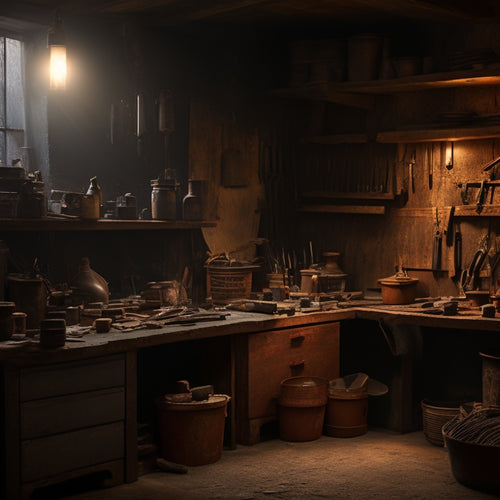
Why You Need the Right Tools for Renovation
Share
When you're undertaking a renovation project, having the right tools can make all the difference between a successful outcome and a costly, time-consuming disaster. You need to identify the essential tools required for your project, including power tools, hand tools, and specialized tools for specific tasks. Investing in high-quality, multipurpose tools can increase versatility and streamline project completion. Safety features, such as ergonomic designs and slip-resistant grips, are also vital. By choosing the right tools, you'll guarantee accuracy, precision, and safety, setting yourself up for a successful renovation. From here, you'll want to explore how to optimize your tool selection to maximize your project's potential.
Key Takeaways
• Investing in high-quality tools enhances efficiency, effectiveness, and project accuracy, leading to professional-grade results and faster completion.
• The right tools improve precision and accuracy, reducing human error risks and costly mistakes in renovation projects.
• Specialized tools for specific renovations, such as tile cutters, streamline project completion and increase versatility.
• Proper tool storage organization and maintenance are crucial for efficiency, accessibility, and prolonging tool life.
• The right tools ensure safety features, such as ergonomic designs and slip-resistant grips, reducing fatigue and discomfort during extended use.
Identifying Essential Tools Needed
Before diving into your renovation project, take stock of the essential tools you'll need to get the job done efficiently and effectively.
You'll want to identify the necessary tool types, including power tools like drills and saws, as well as hand tools like hammers and screwdrivers. Don't forget about specialized tools like tile cutters and grout removers if you're tackling a bathroom or kitchen renovation.
Once you have your list, think about tool storage and organization. You'll need a system to keep your tools within easy reach and protected from damage. Consider investing in a tool chest or cabinet with dividers and compartments to keep everything tidy.
Label each compartment so you can quickly find what you need. A well-organized tool storage system will save you time and frustration on the job site.
Quality Over Cost Considerations
When it comes to selecting tools for your renovation project, you'll inevitably face the dilemma of balancing quality with cost.
You'll need to weigh the short-term savings of cheaper options against the long-term benefits of investing in high-quality tools that will perform consistently and accurately.
High-Quality Tool Investment
Investing in high-quality tools upfront may seem like a costly endeavor, but it's an essential step in ensuring your renovation projects are completed efficiently and effectively, saving you time and money in the long run.
You'll be able to tackle tasks with confidence, knowing that your tools can handle the demands of the job.
Here are three key benefits of investing in high-quality tools:
-
Tool Longevity: High-quality tools are built to last, reducing the need for frequent replacements and minimizing waste. This means you'll spend less money in the long run on tool replacements and maintenance.
-
Maintenance Strategies: With high-quality tools, you'll be able to develop effective maintenance strategies to keep your tools in top condition. This includes regular cleaning, lubrication, and storage, which will extend the life of your tools.
-
Improved Performance: High-quality tools are designed to perform at a higher level, providing you with better results and reducing the risk of errors. This means you'll be able to complete projects faster and with greater accuracy.
Performance Over Price
While it's tempting to opt for cheaper tools to save a buck upfront, you'll ultimately get what you pay for, and prioritizing performance over price is essential to achieving professional-grade results in your renovation projects. Investing in high-quality tools might seem expensive, but it's a worthwhile trade-off for the benefits you'll reap in the long run.
| Tool Aspect | Cheap Tool | High-Quality Tool |
|---|---|---|
| Tool Longevity | Shorter lifespan, frequent replacements | Longer lifespan, reduced maintenance |
| User Experience | Frustrating, inefficient, and tiring | Smooth, efficient, and enjoyable |
| Results | Subpar, inconsistent, and time-consuming | Professional-grade, consistent, and timely |
Precision Matters Most
You'll quickly realize that precision is the key to achieving professional-grade results, and it's an aspect where high-quality tools truly shine.
When you're working on a renovation project, even the slightest miscalculation can lead to costly mistakes and wasted materials. That's why investing in high-quality tools that prioritize precision is vital.
Here are three ways precision matters most in renovation projects:
-
Accurate measurement techniques: High-quality tools often come with advanced measurement techniques, such as laser leveling and precision cutting guides, that guarantee accurate readings and cuts.
-
Tool calibration: High-quality tools are designed to maintain their precision over time, with easy calibration options to make sure that your tools remain accurate even after extended use.
-
Consistent performance: Precision tools are built to deliver consistent results, reducing the risk of human error and guaranteeing that your project turns out exactly as planned.
Safety Features to Look For
When shopping for renovation tools, prioritize those with built-in safety features that can prevent accidents and minimize risks. You want to guarantee that the tools you're using are designed with your safety in mind. Look for tools with ergonomic design, which can reduce fatigue and discomfort, allowing you to work for longer periods without strain. User-friendly features, such as easy-to-grip handles and intuitive controls, can also help prevent accidents.
Here are some key safety features to look for in your renovation tools:
| Tool | Safety Feature | Benefit |
|---|---|---|
| Drill | Slip-resistant grip | Prevents dropping the drill |
| Circular Saw | Blade guard | Protects from accidental cuts |
| Hammer | Cushioned grip | Reduces shock and vibration |
| Ladder | Non-slip feet | Prevents ladder from slipping |
| Sander | Dust collection system | Reduces exposure to dust |
Investing in Multipurpose Tools
Multipurpose tools can be a game-changer in your renovation arsenal, allowing you to tackle a variety of tasks with a single device and greatly reducing clutter in your workspace.
With the right multipurpose tool, you can complete tasks more efficiently, saving you time and energy. This is especially important when working on a renovation project, where every minute counts.
Here are three key benefits of investing in multipurpose tools:
-
Increased tool versatility: Multipurpose tools can perform multiple functions, reducing the need for multiple single-purpose tools.
-
Improved renovation efficiency: By having one tool that can perform multiple tasks, you can complete projects faster and with less hassle.
-
Reduced storage needs: With fewer tools to store, you'll have more space in your workshop or garage, making it easier to find what you need when you need it.
Avoiding Costly Rental Fees
When you're planning a renovation, you'll likely need to rent specialized equipment to get the job done.
However, you don't want to get stuck with idle machines eating into your budget - that's why it's crucial to reduce rental downtime and save on equipment costs.
Reduce Rental Downtime
By streamlining your renovation process, you can greatly cut down on rental downtime, saving yourself from the financial burden of idle equipment and costly rental fees.
This is where effective rental strategies come into play. When you're able to manage your downtime efficiently, you can minimize the amount of time you're paying for equipment that's not in use.
Here are three ways to reduce rental downtime:
-
Schedule equipment rentals in advance: By planning ahead, you can guarantee that the equipment you need is available when you need it, reducing the likelihood of delays and downtime.
-
Implement a downtime management plan: Identify potential bottlenecks in your renovation process and develop a plan to address them. This could include having backup equipment on hand or identifying alternative solutions to keep your project moving forward.
-
Choose equipment with built-in downtime reduction features: Some equipment, such as generators with automatic shutdown features, can help reduce downtime by automatically turning off when not in use. By choosing equipment with these features, you can minimize the amount of time you're paying for equipment that's not in use.
Save on Equipment Costs
You can avoid costly rental fees by adopting strategies that help you optimize your equipment usage and minimize unnecessary expenditures. By doing so, you'll be able to allocate your budget more effectively and make the most of your renovation project.
One key approach is to prioritize budget planning, ensuring you have a clear understanding of your equipment needs and the associated costs. This will enable you to identify areas where you can cut back on unnecessary rentals and allocate funds more efficiently.
Additionally, regular tool maintenance is essential in reducing equipment costs. By keeping your tools in good condition, you'll avoid the need for frequent replacements, which can be a significant expense. Regular maintenance also helps prevent equipment breakdowns, reducing the likelihood of rental downtime and associated costs.
Ensuring Accuracy and Precision
Measure twice, cut once - this old adage still holds true, as even the slightest miscalculation can result in costly mistakes and wasted materials during a renovation project. When it comes to guaranteeing accuracy and precision, you can't afford to take any chances. Having the right tools for the job is vital, and that includes tools that help you measure and calculate with precision.
Here are three essential tools to add to your arsenal:
-
Laser Level: This tool guarantees that your measurements are accurate and level, even on uneven surfaces. It's especially useful for installing cabinets, shelves, and countertops.
-
Digital Caliper: This precision instrument allows you to measure materials with an accuracy of up to 0.01mm. It's perfect for measuring tolerance levels and guaranteeing that your cuts are precise.
-
Angle Finder: This tool helps you measure and mark precise angles, making it ideal for installing stairs, roofs, and other complex structures.
Frequently Asked Questions
Can I Use Old or Second-Hand Tools for Renovation Projects?
When considering using old or second-hand tools for your renovation project, you'll want to think twice.
While it might seem like a cost-effective option, it can compromise tool effectiveness and raise serious safety concerns.
Worn-out or damaged tools can lead to accidents, injuries, and even project delays.
You'll need to weigh the potential risks against any initial cost savings.
How Often Should I Maintain and Clean My Renovation Tools?
Did you know that a single rusty screwdriver can contaminate your entire renovation project, causing delays and extra costs? You should maintain and clean your renovation tools regularly to avoid this.
Set a tool maintenance frequency, ideally after every use, to inspect for damage and wear. Use gentle cleaning tool techniques, like wiping with a soft cloth and mild soap, to remove dirt and grime.
Can I Renovate a Small Area Without Specialized Tools?
You're wondering if you can renovate a small area without specialized tools. The answer is yes, but it depends on your DIY strategies and budget considerations.
If you're willing to put in the elbow grease, you can get by with basic tools like a hammer, tape measure, and screwdriver.
However, if you want to achieve professional results quickly, investing in specialized tools will be worth the cost.
Are There Any Eco-Friendly or Sustainable Renovation Tool Options?
You're looking for eco-friendly renovation tool options? You're on the right track!
Opt for tools made from sustainable materials, like reclaimed wood or recycled metal.
Consider brands that adopt eco-friendly practices, such as energy-efficient production or minimal waste policies.
You can also explore tool rental services to reduce waste and minimize your carbon footprint.
Do I Need to Hire a Professional for Complex Renovation Tasks?
Did you know that 64% of homeowners take on DIY projects to save money?
While that's understandable, you shouldn't risk your safety and property for complex renovation tasks.
When dealing with electrical, plumbing, or structural changes, it's wise to hire a professional.
DIY renovation risks can be costly and even dangerous.
Don't put yourself in a situation where you might end up with a bigger problem than you started with.
Conclusion
You may think you can get by with makeshift tools or borrowing from friends, but don't risk your renovation project's success.
Investing in the right tools may seem like an upfront cost, but it'll save you time, money, and frustration in the long run.
Remember, a good tool is an investment, not an expense.
By choosing quality over cost, you'll avoid costly rework, guarantee accuracy, and get the job done efficiently.
Related Posts
-

Why Invest in Quality Plastering Tools for Renovation
When renovating, investing in quality plastering tools is essential for achieving professional-looking results and mi...
-

Streamlining Your Exterior Renovation Timeline
To streamline your exterior renovation timeline, start by identifying your project goals and objectives, and prioriti...
-

3 Best Planter Shopping Timeline Tips for Renovators
When incorporating planters into your renovation project, you'll want to plan carefully to avoid delays and guarantee...


